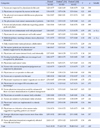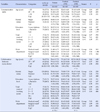Abstract
Purpose
The purpose of this study was to investigate effect of the SBAR-Collaborative Communication Program on nurses' communication skills and on collaboration between nurses and doctors.
Methods
From March 11 to November 11, 2013, data were collected from 180 hospital nurses working in a university hospital in Gyeonggi province. Outcomes were measured at three time intervals; before, three and six months after the program was completed.
Results
After participating in this program, there was a significant increase in nurses'communication skills but not in collaboration between nurses and doctors. None of the participants' general categories influenced nurses'communication skills at pre-test, but age, education level, total years of working and work department significantly influenced scores at 3 and 6 months. Work department was the only category for which there was a significant difference in collaboration between nurses and doctors at pre-test, and education level and work department were related to significant improvement at 6 months.
Conclusion
Findings indicate that this program can improve communication skills for nurses and also, collaboration between nurses and doctors, especially for nurses under 25 years of age. Thus nursing and hospital managers should provide SBAR-Collaborative Communication Programs to new nurses in their job training.
References
1. Marshall S, Harrison J, Flanagan B. The teaching of a structured tool improves the clarity and content of interprofessional clinical communication. Qual Saf Health Care. 2009; 18(2):137–140. DOI: 10.1136/qshc.2007.025247.
2. Leonard M, Graham S, Bonacum D. The human factor: The critical importance of effective teamwork and communication in providing safe care. Qual Saf Health Care. 2004; 13:suppl 1. i85–i90. DOI: 10.1136/qshc.2004.010033.
3. Lingard L, Espin S, Whyte S, Regehr G, Baker GR, Reznick R, et al. Communication failures in the operating room: An observational classification of recurrent types and effects. Qual Saf Health Care. 2004; 13(5):330–334. DOI: 10.1136/qhc.13.5.330.
4. The Joint Commission. Sentinel event statistics data - root causes by event type(2004-2014) [Internet]. cited 2015 April 24. Available from: https://www.jointcommission.org/sentinel_event_statistics.
5. Kramer M, Schmalenberg C. Securing “good” nurse/physician relationships. Nurs Manage. 2003; 34(7):34–38.
6. Lee AK, Yeo JY, Jung SW, Byun SS. Relations on communication competence, job-stress and job-satisfaction of clinical nurse. J Korea Content Assoc. 2013; 13(12):299–308. DOI: 10.5392/JKCA.2013.13.12.299.
7. Kaiser Permanente. SBAR technique for communication: A situational briefing model [Internet]. cited 2015 September 29. Available from: http://www.ihi.org/resources/Pages/Tools/SBARTechniqueforCommunicationASituationalBriefingModel.aspx.
8. Woodhall LJ, Vertacnik L, McLaughlin M. Implementation of the SBAR communication technique in a tertiary center. J Emerg Nurs. 2008; 34(4):314–317. DOI: 10.1016/j.jen.2007.07.007.
9. Haig KM, Sutton S, Whittington J. SBAR: A shared mental model for improving communication between clinicians. Jt Comm J Qual Patient Saf. 2006; 32(3):167–175.
10. De Meester K, Verspuy M, Monsieurs KG, Van Bogaert P. SBAR improves nurse-physician communication and reduces unexpected death: A pre and post intervention study. Resuscitation. 2013; 84(9):1192–1196. DOI: 10.1016/j.resuscitation.2013.03.016.
11. Beckett CD, Kipnis G. Collaborative communication: Integrating SBAR to improve quality/patient safety outcomes. J Healthc Qual. 2009; 31(5):19–28.
12. Randmaa M, Martensson G, Leo Swenne C, Engstrom M. SBAR improves communication and safety climate and decreases incident reports due to communication errors in an anaesthetic clinic: A prospective intervention study. BMJ Open. 2014; 4(1):e004268. DOI: 10.1136/bmjopen-2013-004268.
13. Cunningham NJ, Weiland TJ, van Dijk J, Paddle P, Shilkofski N, Cunningham NY. Telephone referrals by junior doctors: A randomised controlled trial assessing the impact of SBAR in a simulated setting. Postgrad Med J. 2012; 88(1045):619–626. DOI: 10.1136/postgradmedj-2011-130719.
14. Cornell P, Gervis MT, Yates L, Vardaman JM. Improving shift report focus and consistency with the situation, background, assessment, recommendation protocol. J Nurs Adm. 2013; 43(7-8):422–428. DOI: 10.1097/NNA.0b013e31829d6303.
15. Kim EM, Yu M, Ko JW. Development of nurse's handover standards between hospital units using SBAR. J Korean Clin Nurs Res. 2015; 21(1):127–142.
16. Cho HJ. The effect of SBAR program education on a nurse's communication clarify and self expression [master's thesis]. Seoul: Yonsei University;2013.
17. Nelson GA, King ML, Brodine S. Nurse-physician collaboration on medical-surgical units. Medsurg Nurs. 2008; 17(1):35–40.
18. Greenfield LJ. Doctors and nurses: A troubled partnership. Ann Surg. 1999; 230(3):279–288.
19. Jang JY. The relation among nurse's assertiveness, communication competence and job satisfaction, and organizational commitment [master's thesis]. Seoul: Sungkyunkwan University;2010.
20. Oh HK. Communication competence and organization conflicts for nurses in hospital setting [master's thesis]. Daejeon: Chungnam National University;2008.
21. Rubin RB, Martin MM, Bruning SS, Power DE, editors. Interpersonal communication competence: Scale development and test of a self-efficacy model. Atlanta: GA: The meeting of the communication Association;1991.
22. Hur GH. Construction and validation of a global interpersonal communication competence scale. Korean J Journal Commun Stud. 2003; 47(6):380–408.
23. Weiss SJ, Davis HP. Validity and reliability of the collaborative practice scales. Nurs Res. 1985; 34(5):299–305.
24. Coulon L, Mok M, Krause KL, Anderson M. The pursuit of excellence in nursing care: What does it mean? J Adv Nurs. 1996; 24(4):817–826.
25. Copnell B, Johnston L, Harrison D, Wilson A, Robson A, Mulcahy C, et al. Doctors' and nurses' perceptions of interdisciplinary collaboration in the NICU, and the impact of a neonatal nurse practitioner model of practice. J Clin Nurs. 2004; 13(1):105–113. DOI: 10.1046/j.1365-2702.2003.00827.x.
26. Lee YK, Kim OH. Collaboration between nurse-doctor and interpersonal communication competence of nurse. Health Commun. 2009; 4(1):49–57.
27. Faul F, Erdfelder E, Buchner A, Lang AG. Statistical power analyses using G*Power 3.1: Tests for correlation and regression analyses. Behav Res Methods. 2009; 41(4):1149–1160. DOI: 10.3758/brm.41.4.1149.
28. Lee HS, Kim JK. Relationship among communication competence, communication types, and organizational commitment in hospital nurses. J Korean Acad Nurs Adm. 2010; 16(4):488–496. DOI: 10.11111/jkana.2010.16.4.488.
29. Cornell P, Gervis MT, Yates L, Vardaman JM. Impact of SBAR on Nurse Shift Reports and Staff Rounding. Medsurg Nurs. 2014; 23(5):334–342.
30. Hong JY, Kim OH, Lee EK. The relationship among nurse-doctor collaboration, job autonomy and organizational commitment. J Korean Acad Nurs Adm. 2009; 15(4):601–609.




 PDF
PDF ePub
ePub Citation
Citation Print
Print







 XML Download
XML Download